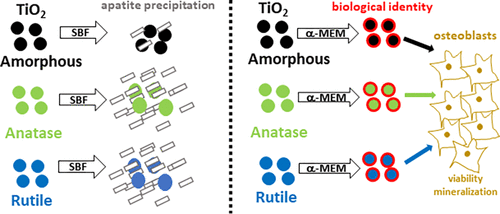Our official English website, www.x-mol.net, welcomes your feedback! (Note: you will need to create a separate account there.)
Characterization of the in Vitro Osteogenic Response to Submicron TiO2 Particles of Varying Structure and Crystallinity.
ACS Omega ( IF 4.1 ) Pub Date : 2020-07-01 , DOI: 10.1021/acsomega.0c00900 Camila B Tovani 1 , Claudio R Ferreira 1 , Ana Maria S Simão 1 , Maytê Bolean 1 , Luca Coppeta 2 , Nicola Rosato 3 , Massimo Bottini 3, 4 , Pietro Ciancaglini 1 , Ana Paula Ramos 1
ACS Omega ( IF 4.1 ) Pub Date : 2020-07-01 , DOI: 10.1021/acsomega.0c00900 Camila B Tovani 1 , Claudio R Ferreira 1 , Ana Maria S Simão 1 , Maytê Bolean 1 , Luca Coppeta 2 , Nicola Rosato 3 , Massimo Bottini 3, 4 , Pietro Ciancaglini 1 , Ana Paula Ramos 1
Affiliation

|
Titanium oxide (TiO2) nano-/microparticles have been widely used in orthopedic and dental sciences because of their excellent mechanical properties, chemical stability, and ability to promote the osseointegration of implants. However, how the structure and crystallinity of TiO2 particles may affect their osteogenic activity remains elusive. Herein, we evaluated the osteogenic response to submicron amorphous, anatase, and rutile TiO2 particles with controlled size and morphology. First, the ability of TiO2 particles to precipitate apatite was assessed in an acellular medium by using a simulated body fluid (SBF). Three days after the addition to SBF, anatase and rutile TiO2 particles induced the precipitation of aggregates of nanoparticles with a platelike morphology, typical for biomimetic apatite. Conversely, amorphous TiO2 particles induced the precipitation of particles with poor Ca/P atomic ratio only after 14 days of exposure to SBF. Next, the osteogenic response to TiO2 particles was assessed in vitro by incubating MC3T3-E1 preosteoblasts with the particles. The viability and mineralization efficiency of osteoblastic cells were maintained in the presence of all the tested TiO2 particles despite the differences in the induction of apatite precipitation in SBF by TiO2 particles with different structures. Analysis of the particles’ surface charge and of the proteins adsorbed onto the particles from the culture media suggested that all the tested TiO2 particles acquired a similar biological identity in the culture media. We posited that this phenomenon attenuated potential differences in osteoblast response to amorphous, anatase, and rutile particles. Our study provides an important insight into the complex relationship between the physicochemical properties and function of TiO2 particles and sheds light on their safe use in medicine.
中文翻译:

表征不同结构和结晶度的亚微米TiO2颗粒的体外成骨反应。
氧化钛(TiO 2)纳米/微粒因其优异的机械性能,化学稳定性以及促进植入物骨整合的能力而被广泛应用于整形外科和牙科科学。然而,TiO 2颗粒的结构和结晶度如何影响其成骨活性仍不清楚。在本文中,我们评估了对亚微米无定形,锐钛矿和金红石型TiO 2颗粒的成骨反应,并控制了其尺寸和形貌。首先,通过使用模拟体液(SBF)在无细胞培养基中评估TiO 2颗粒沉淀磷灰石的能力。加入SBF,锐钛矿和金红石TiO 2后三天颗粒诱导了具有仿生磷灰石典型特征的板状形态的纳米颗粒聚集体的沉淀。相反,无定形的TiO 2颗粒仅在暴露于SBF 14天后才引起Ca / P原子比差的颗粒沉淀。接下来,通过将MC3T3-E1前成骨细胞与颗粒一起孵育,体外评估了对TiO 2颗粒的成骨反应。成骨细胞的生存力和矿化效率在所有测试的TiO 2的存在下,保持2颗粒,尽管通过的TiO在SBF磷灰石沉淀的诱导的差异2具有不同结构的粒子。对颗粒表面电荷和从培养基中吸附到颗粒上的蛋白质的分析表明,所有测试的TiO 2颗粒在培养基中都具有相似的生物学特性。我们认为,这种现象减弱了成骨细胞对无定形,锐钛矿和金红石颗粒的反应中的潜在差异。我们的研究为TiO 2颗粒的理化性质与功能之间的复杂关系提供了重要的见解,并为TiO 2颗粒在医学上的安全使用提供了线索。
更新日期:2020-07-14
中文翻译:

表征不同结构和结晶度的亚微米TiO2颗粒的体外成骨反应。
氧化钛(TiO 2)纳米/微粒因其优异的机械性能,化学稳定性以及促进植入物骨整合的能力而被广泛应用于整形外科和牙科科学。然而,TiO 2颗粒的结构和结晶度如何影响其成骨活性仍不清楚。在本文中,我们评估了对亚微米无定形,锐钛矿和金红石型TiO 2颗粒的成骨反应,并控制了其尺寸和形貌。首先,通过使用模拟体液(SBF)在无细胞培养基中评估TiO 2颗粒沉淀磷灰石的能力。加入SBF,锐钛矿和金红石TiO 2后三天颗粒诱导了具有仿生磷灰石典型特征的板状形态的纳米颗粒聚集体的沉淀。相反,无定形的TiO 2颗粒仅在暴露于SBF 14天后才引起Ca / P原子比差的颗粒沉淀。接下来,通过将MC3T3-E1前成骨细胞与颗粒一起孵育,体外评估了对TiO 2颗粒的成骨反应。成骨细胞的生存力和矿化效率在所有测试的TiO 2的存在下,保持2颗粒,尽管通过的TiO在SBF磷灰石沉淀的诱导的差异2具有不同结构的粒子。对颗粒表面电荷和从培养基中吸附到颗粒上的蛋白质的分析表明,所有测试的TiO 2颗粒在培养基中都具有相似的生物学特性。我们认为,这种现象减弱了成骨细胞对无定形,锐钛矿和金红石颗粒的反应中的潜在差异。我们的研究为TiO 2颗粒的理化性质与功能之间的复杂关系提供了重要的见解,并为TiO 2颗粒在医学上的安全使用提供了线索。


























 京公网安备 11010802027423号
京公网安备 11010802027423号